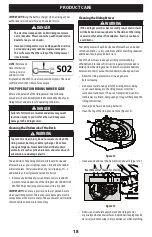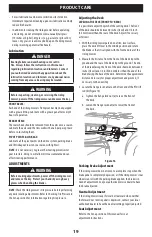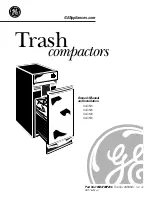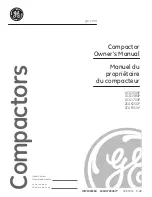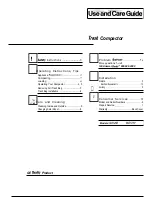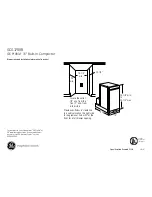
4
SAFE OPERATION PRACTICES
SLOPE OPERATION
1. Slopes are a major factor related to loss of control and tip-
over accidents which can result in severe injury or death. All
slopes require extra caution. If you cannot back up the slope,
or if you feel uneasy on it, do not mow or drive on it.
2. For your safety, measure any slope before using the riding
mower on the sloped area. Use a slope measuring device in
addition to the slope gauge included as part of this manual
to measure slopes before operating this riding mower on a
sloped or hilly area. Smart phone applications can also be
utilized to measure slopes. If the slope is greater than 12°
(21%) as shown on the slope gauge or a slope measuring
device, do not operate this riding mower on that area or
serious injury could result.
3. Do not mow on slopes greater than 12° (21%).
4. Do not mow across slopes, only mow up or down slopes
that are less than 12° (21%). Use low speeds and avoid
sudden turns.
5. Do not mow on wet grass. Reduced traction could cause
sliding or a loss of control.
6. Do not operate riding mower under any conditions where
traction, steering, or stability is in question. Tires could slide
even if the wheels are stopped.
7. Avoid starting and stopping on slopes. Avoid making
sudden changes in speed or direction. Make turns slowly
and gradually.
8. Use extra care while operating riding mower with grass
catcher or other attachment(s). They can affect the stability
of the riding mower. Do not use grass catcher on slopes
greater than 10° (17%).
9. Do not try to stabilize the riding mower by putting your foot
on the ground.
10. Keep all movement on slopes slow and gradual. Do not make
sudden changes in speed or direction. Rapid acceleration
could cause the front of the riding mower to lift and rapidly
tip over backwards, which could cause serious injury or death.
11. Do not turn off riding mower and freewheel downhill. Over-
speeding may cause the operator to lose control of the riding
mower resulting in serious injury or death.
SLOPE GAUGE (BACK COVER)
WARNING
Slopes are a major factor related to slip and fall accidents
which can result in severe injury or death. All slopes
require extra caution. If you feel uneasy on the slope, do
not mow it. Do not mow on slopes greater than 12° (21%).
Only mow up and down slopes, never across slopes.
USE THE SLOPE GAUGE ON THE BACK COVER AS SHOWN TO
DETERMINE IF A SLOPE IS TOO STEEP FOR SAFE OPERATION!
To check the slope, proceed as follows:
1. Open manual to the back cover and fold along the
dashed line.
2. Locate a vertical object on or behind the slope (e.g. a pole,
building, fence, tree, etc.).
3. Align either side of the slope gauge with the object.
4. Adjust gauge up or down until the left corner touches
the slope.
5. If there is a gap below the gauge, the slope is too steep for
safe operation.
HAULING
1. Use properly secured full width ramps for loading and
unloading a riding mower for transport.
2. Use extra care when loading or unloading the riding mower
into a trailer or truck. This riding mower should not be driven
up or down ramp(s) because the riding mower could tip over,
causing serious personal injury. The riding mower must be
pushed manually on ramp(s) to load or unload properly.
3. Raise the deck to the highest position for loading clearance.
4. Do not tow this riding mower, damage to the drive motors
can occur.
TOWING
1. Do not tow a load that exceeds 250 lbs (113 kg) rolling weight
and never exceed 50 lbs (22 kg) tongue weight.
2. Do not attach towed equipment except at the hitch point of
the riding mower.
3. Never allow children or others in or on towed equipment.
4. Do not tow on slopes greater than 5° (9%). On slopes, the
weight of towed equipment may cause loss of traction and
loss of control and/or the ability to stop.
5. Always use extra caution when towing with a riding mower
capable of making tight turns (e.g. tight-turn riding mower).
Make wide turns to avoid jack-knifing.
6. Travel slowly and allow extra distance to stop.
SERVICE
1. Keep riding mower in good working order. Do not use the
riding mower until worn or damaged parts are replaced.
2. Riding mower blade(s) are sharp. Wrap the blade or wear
gloves, and use extra caution when servicing them.
3. Remove key and store the riding mower indoors when not
in use. Allow the riding mower to cool at least five minutes
before charging or storing.
4. Before cleaning, repairing, or inspecting, make certain the
blade(s) and all moving parts have stopped. Turn off riding
mower and remove the key.
Summary of Contents for 33 27JD Series
Page 78: ...NOTES NOTAS NOTES ...
Page 79: ...NOTES NOTAS NOTES ...


















